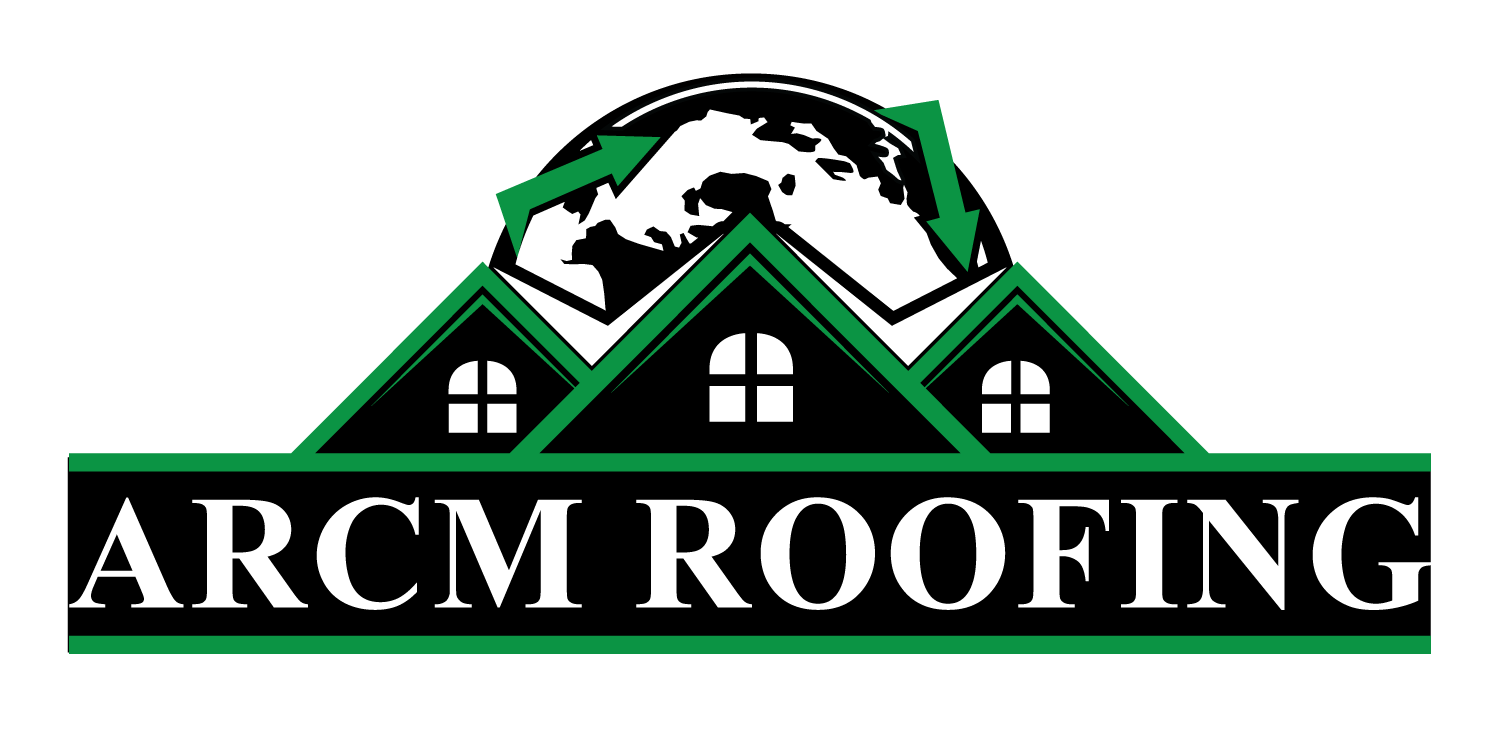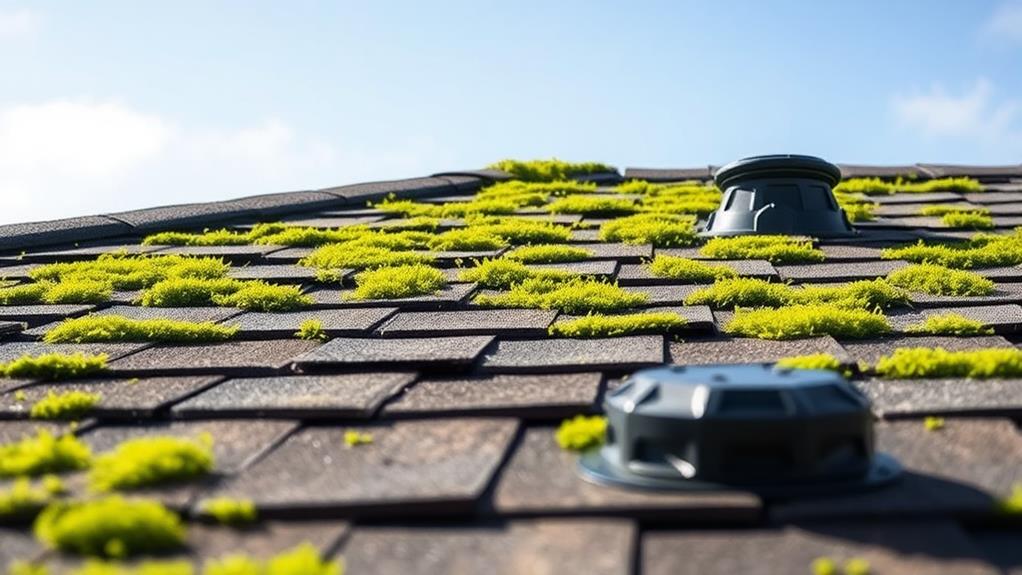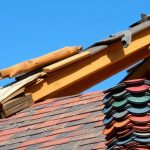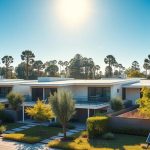Preventing roof mold involves maintaining proper ventilation, addressing water infiltration, and routinely inspecting roofing materials. Mold thrives in moist environments, exacerbated by factors such as poor attic ventilation and overhanging trees that trap humidity. To mitigate these conditions, integrating mold-resistant materials and regular inspections can avert structural damage and safeguard air quality. Recognizing early indicators such as shingle discoloration, musty odors, or respiratory symptoms in occupants is essential. Professional roofing contractors offer thorough mold prevention solutions, using advanced technology and preventative treatments to protect against mold spore proliferation. For an in-depth understanding of these strategies and benefits, seek further insights.
Roofing Highlights
- Ensure proper attic ventilation to prevent moisture accumulation and discourage mold growth.
- Regularly inspect and maintain gutters to prevent water backup and roof mold.
- Use mold-resistant roofing materials and coatings for proactive mold prevention.
- Trim overhanging trees to allow sunlight and reduce moisture retention on the roof.
- Schedule routine roof inspections to identify and address mold indicators early.
Definition of Roof Mold
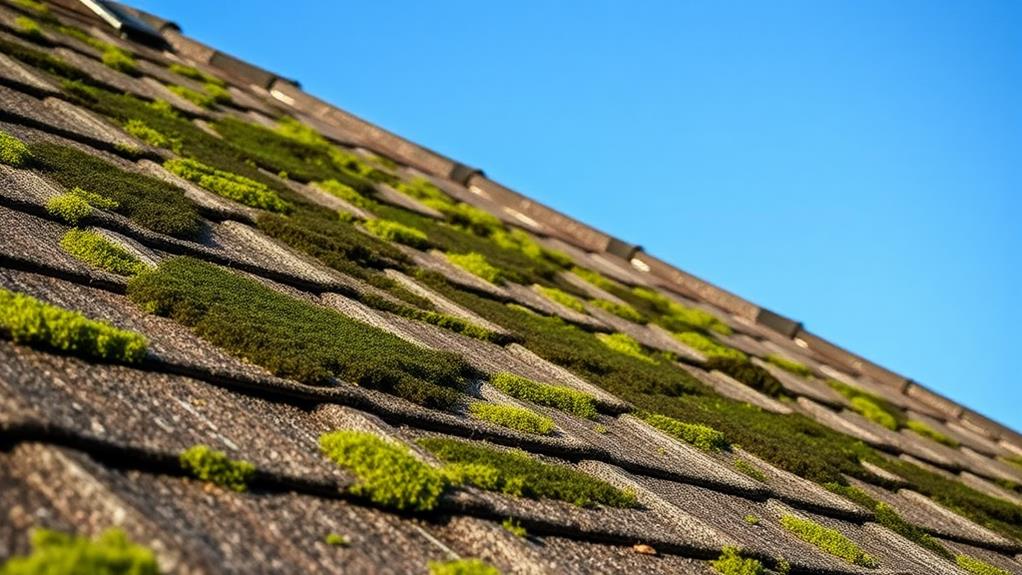
Roof mold, a common concern for homeowners, is a type of fungus that thrives in moist environments, often resulting from poor ventilation or water infiltration. Recognizing the symptoms, such as discoloration and musty odors, is pivotal for early identification and prevention of further damage.
Locations with frequent storms, like Colorado, are particularly at risk, as storm damage can lead to roof vulnerabilities that promote mold growth. Different types of mold, including black and green molds, can dramatically impact the structural integrity and air quality of a building, making it essential to understand their causes and manifestations for effective mitigation.
Causes of Roof Mold
Mold is a type of fungus that thrives in damp, humid environments, making roofs a prime target for its growth. Several factors contribute to the ideal conditions for mold proliferation on roofs, creating a need for vigilant prevention. One of the primary causes is moisture accumulation, often stemming from poor ventilation in the attic space. Without adequate airflow, condensation can develop, especially during seasonal changes, fostering an environment conducive to mold.
Additionally, roofs shaded by overhanging trees can retain moisture longer, as sunlight is hindered from drying the surface effectively.
In addition, roofing materials themselves can sometimes contribute to mold growth. Materials that accumulate organic matter, such as leaves or twigs, can facilitate mold, as they provide both moisture retention and a nutrient-rich environment. The climate also plays a pivotal role; regions with high humidity and frequent rainfall are more susceptible to mold issues as these conditions inherently support fungal growth.
While initial signs may be subtle, understanding these factors positions one to implement proactive measures, ensuring that roofs remain resistant to mold. By addressing these moisture sources, you contribute to preserving the integrity of your roof and, by extension, the safety and comfort of your home environment.
Identifying Mold Symptoms
The presence of mold on a roof can manifest subtly at first, but recognizing the symptoms early is critical for effective mitigation. Homeowners united in the quest to maintain the integrity of their homes must be vigilant in spotting the early signs of mold, ensuring that minor issues do not progress into extensive damage. Typically, discoloration on roof shingles or tiles provides the first indication; patches of black, green, or brown may appear, suggesting mold colonization. This visual cue is often accompanied by a persistent musty odor that can permeate into interior spaces, signifying a deeper issue within the roof structure itself.
Mold symptoms extend beyond mere appearance; their presence can exacerbate respiratory symptoms for occupants, such as increased coughing or allergy-like reactions, signaling the infiltration of spores into the living environment. Furthermore, symptoms might include visible deterioration or warping of materials around the roof area, which suggests moisture retention — a common precursor to mold development. Additionally, during seasonal changes, homeowners may notice persistent ice damming or blocked gutters, creating a moisture-laden environment conducive to mold. By understanding these symptoms, community members can collectively safeguard their homes, fostering a shared sense of security and care.
Mold Types and Impact
Understanding various types of mold that can affect roofs is essential for effective prevention and mitigation strategies. Roof mold not only undermines the structural integrity of a building but also poses potential health risks to its inhabitants. Several types of mold typically thrive on rooftops, chiefly due to moisture accumulation, organic debris, and inadequate ventilation. Among the most common varieties are Cladosporium, Alternaria, and Aspergillus, each capable of colonizing various roofing materials.
Cladosporium, characterized by its resilience and ability to grow in cooler climates, often appears as dark green or black patches, especially after periods of heavy rainfall. Alternaria is primarily known for thriving in warmer weather, generally manifesting as brown or gray spots. Aspergillus, with its wide color variation, tends to settle in areas with consistent dampness, potentially accelerating the deterioration of roofing materials.
The impact of these mold types extends beyond mere cosmetic damage. Structural components are at risk of rot and decay, increasing the likelihood of leaks and water damage. In addition, mold spores can become airborne, entering the living spaces underneath, potentially triggering allergic reactions or respiratory issues. Consequently, understanding and addressing these mold types is critical to ensuring a safe and healthy environment.
Benefits

Preventing roof mold not only contributes to a healthier living environment by mitigating allergens and respiratory risks but also safeguards the structural integrity and longevity of your roof through the avoidance of moisture damage and decay. This proactive approach not only prevents the spread of mold but also enhances the aesthetic appeal and overall value of your property, proving to be a judicious investment.
Consequently, adopting thorough roof mold prevention measures is beneficial in maintaining both the safety of its occupants and the financial viability of your real estate asset. In regions like Denver, Colorado, where weather conditions can challenge roofing materials, working with trusted firms such as ARCM Roofing can further aid in the preservation of your home's roof.
Healthier Living Environment
Guaranteeing a home is free of roof mold offers numerous benefits that contribute to a healthier living environment. When roof mold is effectively managed, the quality of indoor air is markedly improved, reducing the risk of respiratory ailments such as asthma and allergies. Mold spores, when airborne, can infiltrate living spaces, compromising air purity and causing or exacerbating health issues.
By preventing mold growth, one safeguards the inhabitants' health, creating a sanctuary of well-being and contentment.
Additionally, a mold-free roof promotes a sense of community well-being, as it underscores a commitment to maintaining property integrity and aesthetic appeal. Neighbors are reassured when homes in their vicinity uphold higher health and safety standards, fostering a sense of collective belonging. Importantly, preventing mold also guarantees that emotional and psychological domains are not overlooked. Living under a roof free from mold-related stressors allows homeowners to feel comfortable and confident in their surroundings.
Moreover, the absence of roof mold mitigates other structural hazards within the home, further securing a stable and sound living environment. This quiet assurance forms a foundation upon which homeowners can build their lives, secure in the knowledge of their proactive care and diligence.
Increased Roof Longevity
A well-maintained roof is a cornerstone of property value, and preventing mold growth plays a pivotal role in increasing roof longevity. Mold thrives in damp environments, compromising roofing materials by breaking them down and accelerating their deterioration. This insidious growth can lead to costly repairs or even premature roof replacement, both of which can be avoided with effective mold prevention measures.
The effects of mold extend beyond the visible to the structural, as spores infiltrate roofing components like shingles, underlayment, and insulation. This infiltration weakens the structural integrity of the roof over time, leading to leaks and potential water damage to interior spaces. By addressing these issues through regular inspections and maintenance, property owners guarantee that their roofs remain robust against weather elements, extending their lifespan substantially.
Furthermore, using mold-resistant materials or coatings during roof installation can serve as a proactive defense against mold proliferation. These preventative strategies equip homeowners with the knowledge and tools to protect their investment, ensuring a durable roofing structure. By staying vigilant and adopting comprehensive measures, homeowners can rest assured knowing their roof will endure for years, imbibing a sense of security and community within their environment.
Enhanced Property Value
Maintaining a mold-free roof not only enhances the longevity of the structure but also contributes greatly to boosting property value. This accrual in property value is significant, as a well-maintained roof prevents mold-related damages that can deter potential buyers.
A clean, resilient roof serves as a visible indicator of overall property care, reflecting positively on the home's condition and increasing its market appeal. Correspondingly, a roof devoid of mold can translate into a more significant financial return on investment when selling the property, as homeowners can expect fewer repair negotiations and possibly higher offers.
Furthermore, frequent prevention and remediation measures eliminate the need for costly repairs by proactively addressing roof mold issues. This financial prudence and demonstrated commitment to property upkeep are attractive not only to future owners but also to appraisers, who might assess the property at a higher value, given its apparent condition and care.
For homeowners who cherish belonging to a community of responsible property stewards, investing in mold prevention epitomizes a shared commitment to maintaining and enhancing the aesthetic and functional value of homes. In effect, this diligent care fosters a neighborhood ambiance distinguished by pride of ownership and mutual respect.
Common Roof Mold Signs

When maintaining a healthy roof, identifying early signs of mold development is pivotal for homeowners, as these indicators can prevent extensive damage and costly repairs. Discoloration and stains on shingles, accompanied by a persistent musty odor, often signal the presence of mold, which thrives in damp conditions and can infiltrate your home without timely intervention. Additionally, unexplained water spots on the ceiling could indicate moisture accumulation above, further pointing to potential mold issues.
| Sign | Description |
|---|---|
| Discoloration and Stains | Visible changes in shingle color, often green or black spots |
| Musty Odor Presence | Persistent earthy smell, especially after rain |
| Ceiling Water Spots | Brown or yellow circles indicating water seepage |
| Deteriorating Shingles | Cracked or curling shingles revealing underlying issues |
| Increased Allergies | Heightened allergy symptoms due to mold spores in the air |
Discoloration and Stains
One of the most unmistakable signs of roof mold is the appearance of discoloration and stains, which can manifest as dark streaks or patches on roofing materials. These blemishes are often mistakenly attributed to simple dirt or aging; however, their persistent nature is a red flag for mold proliferation.
Mold thrives in environments that provide moisture and organic matter, conditions often met by shaded areas of the roof or where water might accumulate due to poor drainage or clogged gutters. As mold spores colonize and expand, they secrete enzymes that digest materials, leading to these visible stains.
Professional inspection is advisable when discoloration is observed. Experts can determine whether the staining is mold-related and to what extent it has compromised the roof's structural integrity. It's important to understand that if left unaddressed, these mold marks are not merely cosmetic; they can lead to deeper issues affecting the overall lifespan and safety of the roofing system.
Addressing such signs early through proper cleaning, repair, and preventive measures fosters not only the longevity of the roof but also enhances a sense of security and pride within the community of homeowners who value the safety and aesthetic of their living environments.
Musty Odor Presence
Beyond visible signs such as discoloration and stains, the presence of a musty odor is another indicator of roof mold that should not be overlooked. This distinctive smell is often an initial clue signaling concealed mold growth within a roof's infrastructure. It occurs when spores convert moisture into mildew, producing an earthy, unpleasant scent that pervades the living space. While mold's musty odor does not exclusively confirm its presence, it provides an early warning to facilitate timely inspection and intervention, fundamental for maintaining the structural integrity and safety of one's home.
In environments where community and safety are cherished, recognizing these odors can empower property owners to take effective action, preventing mold-related health complications and structural damage. This odor often intensifies after rainfall or periods of increased humidity, as moisture serves to invigorate mold proliferation within roofing materials, attics, and interconnected spaces. Engaging professional inspection services upon detecting such odors is essential. Specialists employ extensive diagnostic tools to determine sources of moisture intrusion, conduct air quality assessments, and recommend appropriate remediation solutions. By prioritizing early detection and treatment, homeowners cultivate not only a safer living environment but a shared commitment to wellbeing and collective home pride.
Ceiling Water Spots
Ceiling water spots serve as an essential indicator of potential roof mold issues, revealing underlying moisture problems. These telltale marks often appear as discolored patches, ranging from pale yellow to dark brown, and may signal leaks or condensation issues originating from the roof. Such spots can manifest not just as superficial blemishes but may also portend more persistent and damaging problems, threatening the structural integrity of the building if left unchecked.
Addressing ceiling water spots requires a nuanced understanding of roof anatomy and moisture dynamics. A proactive approach involves inspecting the roof for damaged or missing shingles, clogged gutters, or inadequate ventilation—each a potential contributor to moisture accumulation. Additionally, paying close attention to the condition of attic insulation can help in identifying heat loss areas, which could exacerbate condensation problems and ultimately lead to mold proliferation.
Collaborating with professional roofing contractors can provide an invaluable sense of camaraderie, tapping into their expertise for thorough assessments and effective remediation strategies. By collectively addressing the root causes of ceiling water spots, individuals can foster a sense of community through shared responsibility, ensuring a mold-free environment that preserves both health and property value for everyone involved.
Connect With Us
We ascertain the significance of upholding a safe and healthy home milieu, free from the hazards of roof mold. Don't wait until it's too late—take proactive steps to protect your home and loved ones.
Connect with our expert team today for personalized advice and solutions to prevent roof mold before it becomes a problem. Call us now at (303) 306-8384 and guarantee peace of mind with a mold-free roof. Your home deserves the best; let us assist you in attaining it!
Roofing FAQ
How Often Should I Inspect My Roof for Mold Growth?
Regular inspections are vital to maintaining a healthy home environment. Conduct roof assessments at least twice annually and after severe weather events. This consistent vigilance fosters a sense of community responsibility and proactive care among homeowners.
Can Roof Mold Affect Indoor Air Quality?
Yes, mold growth on roofs can profoundly impact indoor air quality. Spores can infiltrate living spaces, exacerbating respiratory issues and allergies. Regular monitoring and maintenance are critical to guarantee a healthy environment within the home for all members.
What Are the Main Causes of Roof Mold?
Understanding the causes of mold is essential for maintaining a safe, healthy environment. Roof mold primarily results from inadequate ventilation, excessive moisture from leaks or humidity, and organic materials offering nourishment. Prevention strengthens community health and property longevity.
Are There Eco-Friendly Products for Cleaning Roof Mold?
Eco-friendly products for mold cleaning include solutions with low volatile organic compounds (VOCs) or plant-based ingredients. These products guarantee safety and sustainability, promoting environmental responsibility while effectively maintaining the aesthetic and structural integrity of your property.
Can Roof Mold Spread to Other Parts of the House?
Indeed, mold originating on the roof can infiltrate other areas of a home, potentially affecting indoor air quality and structural integrity. Community-based solutions can foster a shared commitment to promptly addressing mold issues, ensuring a safer living environment.
